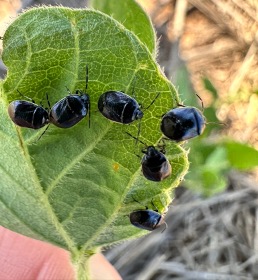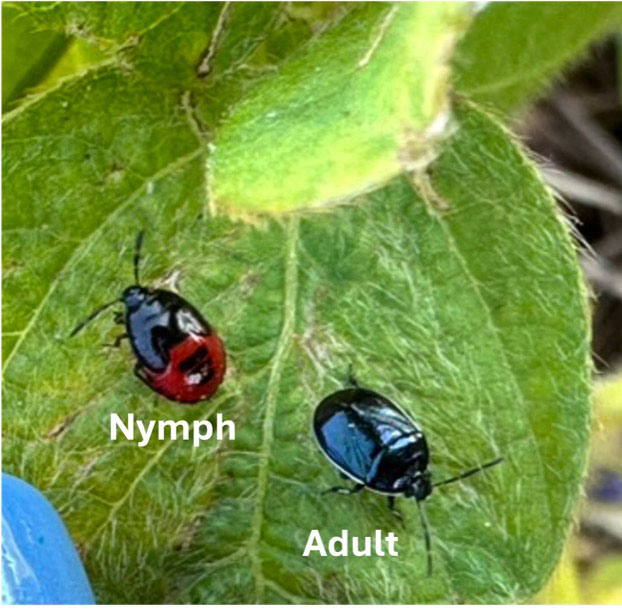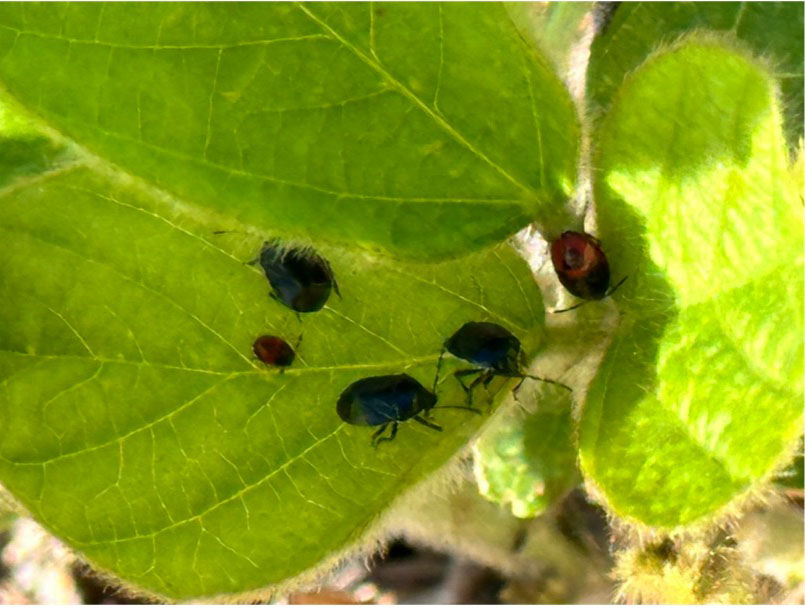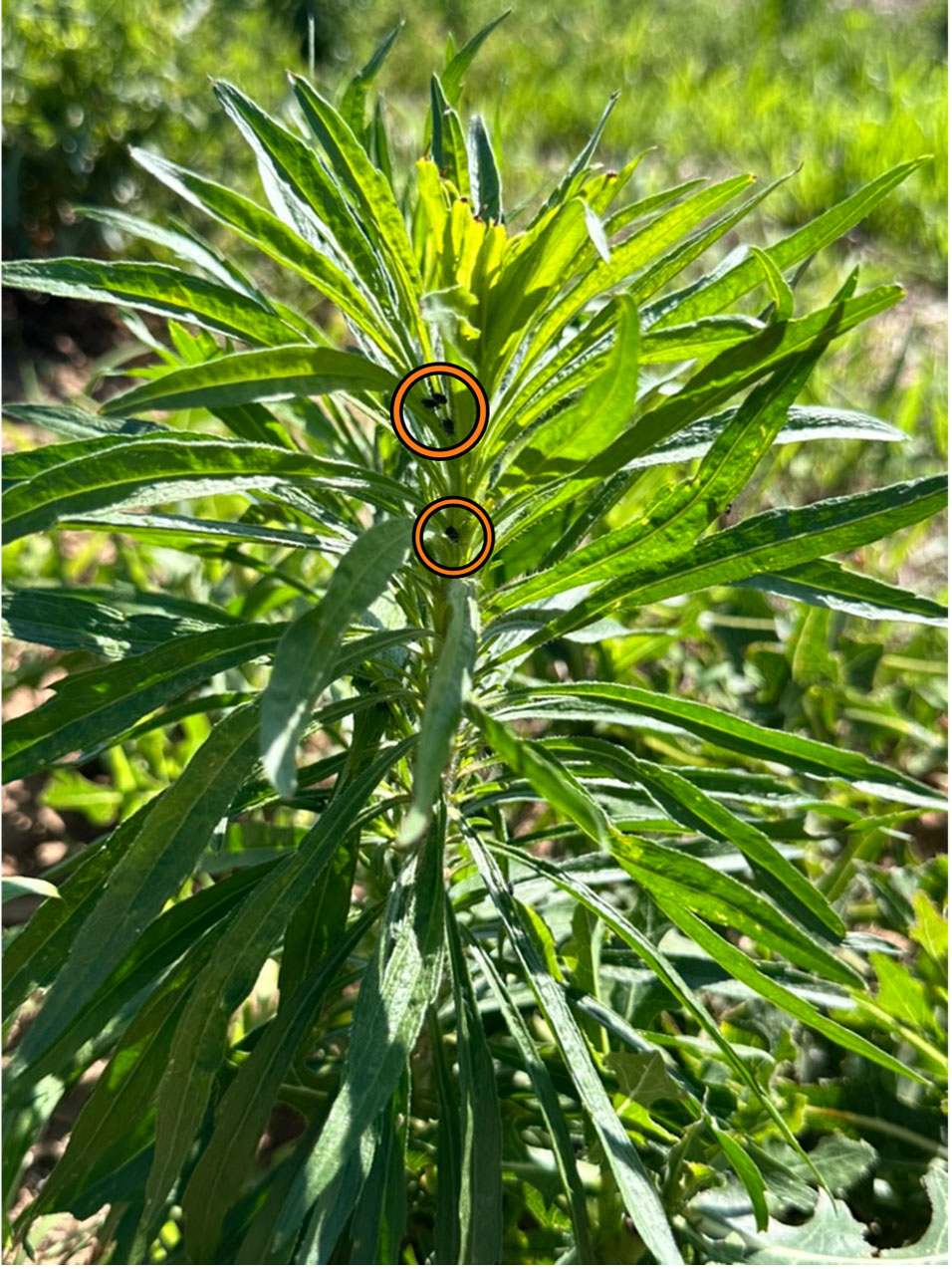Is it a pest? White-margined Burrower Bug (AKA the Mother Bug) in Soybeans and at Home
This week started with an observation of numerous, white-margined burrower bugs, Sehirus cinctus, on full-season, early planted soybeans (planted April 10, 2024) at the Oklahoma State University Cimarron Valley Research Station in Perkins, OK. OSU Cropping Systems Specialist Josh Lofton was at the station on the morning of Monday, May 27 when he noticed several of these bugs on soybeans in vegetative and R1 stages (Figure 1). Although the number of these bugs on the soybeans (up to 6-12 per plant) was alarming, the white-margined burrower bug is fortunately not an economically important pest. However, its propensity for being present in large numbers in agricultural fields and outside of homes does make this an insect that many people notice and may wonder if they should be concerned. Fortunately these insects do not cause any harm to crops or people, but they do have an interesting biology and people may find them to be a nuisance if they accidentally invade their homes.
Figure 1. Adult, white-margined burrower bugs on a soybean leaf. (Photo: Ashleigh M. Faris, Oklahoma State University)
Identification and Biology
White-margined burrower bugs belong to the same taxonomic order as stinkbugs (Order Hemiptera) and share a similar shape. Unlike stinkbugs, burrower bugs have spines that cover their lower legs that aid in digging. Adults are shiny black in appearance with a white border that runs along the insect’s thorax and abdomen, and measure about a quarter of an inch long (Figure 2). Nymphs are wingless; they will have a black head and thorax, and a red abdomen with black markings (Figure 2). At first glance, one may first confuse nymphs for lady beetles due to their black and red coloring. Nymphs will grow as they feed and molt, until they turn into reproductive and winged adults. White-margined burrower bugs only produce one generation per year, but a female can lay up to 150 eggs. Adults will overwinter then mate in the spring and lay eggs in soil. Eggs typically hatch around mid-May which coincides with Mother’s Day, one of the reasons for the insect’s common name of “the mother bug”.
Figure 2. Nymph and adult forms of the white-margined burrower bug on soybean plant. (Photo: Ashleigh M. Faris, Oklahoma State University)
Another reason this insect is called the mother bug is due to its rather unique (in terms of the insect world) maternal care behavior. Not only does she guard the eggs that she has laid, but once the nymphs hatch, the mother will bring them seeds to feed on. Because of how rare this maternal care behavior is in the insect world their behavior is of interest to biologists and ecologists. Like other hemipterans, these insects feed using their piercing-sucking mouthparts. Typically, they feed on developing seeds of a wide variety of host plants. They prefer plants such as nettles (e.g. purple deadnettle or horsenettle), henbit, and other mints. They have also been found on lamb’s ear, as well as on herbaceous flowers and leaves. Unlike other burrower bugs, the white-margined burrower bug is typically found on plants, not hidden and living in the ground like other burrower bugs which can be agricultural pests. In the heat of the day, the bugs will move to the underside of leaves and areas of shade, such as the whorls of developing sorghum plants.
Management Guidance
Periodic outbreaks have been documented in different cropping systems (most commonly soybeans), cracks of home and building exteriors, sidewalks, and cracked soil. It does appear that these outbreaks are sporadic. While an infestation may be noticed in one location it doesn’t necessarily mean the insects will also be found in neighboring fields or structures. Outbreaks seem to occur once every several years. At the Cimarron Research Station, adults were also found on marestail (horseweed), Conyza canadensis, within the soybean plot (Figure 3).
Figure 3. Adult white-margined burrower bugs (circled) on marestail (horseweed), Conyza canadensis. (Photo: Ashleigh M. Faris, Oklahoma State University)
Homeowners may view these insects as a nuisance if they invade a home. In fact, our neighbors to the south have seen an influx of these bugs in the Dallas, TX metroplex earlier this May. However, these insects are harmless as they do not bite or sting humans or animals. In terms of agricultural production, the white-margined burrower bug is not known to vector pathogens of disease and their feeding has no economic impact. In instances where populations build and begin to invade structures, homeowners can use a synthetic pyrethroid that can halt the movement of the bugs into homes. When applying any pesticide be sure to always follow the label’s instructions for use and precautions. Be especially mindful of applications in areas where humans and pets frequent.
References
McDowell, B. 2024. Pest Alert! White-margined burrower bug. Insects in the City. Texas A&M AgriLife Extension. Accessed: May 29, 2024.
Porter, P. 2011. The Mother bug. Insects in the City. Texas A&M AgriLife Extension. Accessed: May 29, 2024.
Porter, P. 2014. The “Mother” bug II. Insects in the City. Texas A&M AgriLife Extension. Accessed: May 29, 2024.
Sites, R.W. and J. E. McPherson. 1982. Life History and Laboratory Rearing of Sehirus cinctus cinctus (Hemiptera: Cydnidae), with Descriptions of Immature Stages. Ann. Entomol. 75:2, p. 210-15.
Whitworth, R.J., H. Davis, and A. Norton. 2022. Kansas Crop Pests: Burrowing Bugs. MF3613. Kansas State University Agricultural Experiment Station and Cooperative Extension Service. Accessed: May 29, 2024.
Wright, R. and J. McMechan. 2018. Burrower Bugs in Soybeans. CROPWATCH. University of Nebraska-Lincoln. Accessed: May 29, 2024.




